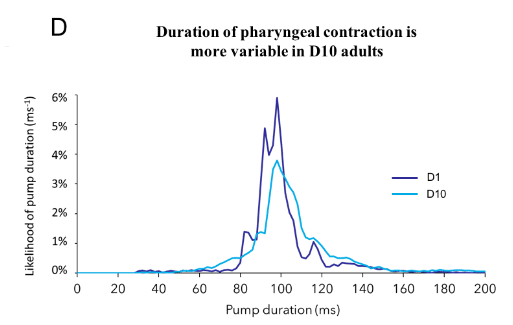We know that C. elegans’ feeding behavior strongly influences the worm’s aging and longevity1. So, a couple of months ago, we decided to test adult worms from Day 1 to Day 15 to quantify how aging affects their feeding behavior. As expected, we saw that the pumping frequency decreases with age, but a noticeable difference in the pattern of pumping caught our eyes. It appeared that in older adults, the pharyngeal pumping was weaker and less regular.
Last week, we went back to our data to dissect the feeding pattern of those worms. Looking at both the length and distribution of intervals between pumps, we were very excited to find that the worms make longer and more frequent pauses as they age. We expected the amplitude of the pumps to increase along with the size3 and age of the worms, but instead we saw a significant decrease in pumping amplitude. This previously undocumented behavior is consistent with the normal decline in muscle strength and coordination that occurs during aging, both in worms and in mammals.
Compared to Day 1 N2 adult worms, Day 10 worms exhibit dramatically impaired pharyngeal muscle activity. The decreased pumping rate (not shown), together with the increased interpump interval (A) and lower signal amplitude (B) are consistent with pharyngeal functional and structural decline during aging2. (C) Day 1 adult worms pump at a steady frequency whereas Day 10 worms show multiple abrupt decreases in pump frequency over a 2-minute recording (red arrows). (D) The distribution of pharyngeal contraction (pump) durations show that the range of pump duration is increased at Day 10 compared to Day 1. Pump events in Day 10 worms are less consistent (increased likelihood of observing shorter (<80 ms) or longer pumps (>102 ms)) (p=0.038 at the 95th percentile). A-B: n > 16; **p= 2.54 10-3; ***p=2.04 10-8; C-D: Data from 1 worm, representative of population. All worms were recorded in 10mM serotonin in M9 for a minimum of 2 minutes.
1. Piper and Bartke, 2008 2. Chow et al, 2006 3. Lockery et al, 2013
Enhance your research capabilities with InVivo Biosystems’ premium transgenic services. We would be delighted to receive your inquiry regarding our services.
ScreenChip System Overview Request More Information




